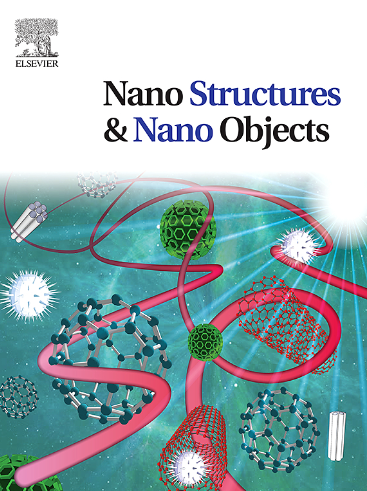金属氧化物纳米颗粒及其衍生复合材料的光催化活性研究
IF 5.45
Q1 Physics and Astronomy
引用次数: 0
摘要
在这项研究中,我们分析了脉冲电子束蒸发法制备的纳米粉末(NPs)的光催化活性。具体来说,我们研究了在不同温度下退火的TiO2, CeO2 NPs,以及Bi2O3, ZnO-Zn, ZrO2, Al2O3, SiO2, Fe2O3 NPs,包括通过辐射化学方法包覆和掺杂纳米银的NPs (Ag-ZrO2, Ag-ZnO-Zn, Ag-Bi2O3, Ag-SiO2, Ag-Fe2O3)。我们研究了有机染料甲基紫(橙色)在NPs悬浮液中在紫外线照射下的降解过程,并深入研究了影响光催化活性的因素。研究表明,纳米银的掺杂和包覆对光解速率有积极的影响。此外,我们确定了铋、硅和氧化锌NPs的最佳退火温度,相应的光催化活性增加。值得注意的是,在样品活性和带隙与应用辐照源光谱的比值之间建立了相关性。本文章由计算机程序翻译,如有差异,请以英文原文为准。
Investigation of the photocatalytic activity of metal oxide nanoparticles and their derived composites
In this study, we conducted an analysis of the photocatalytic activity of nanopowders (NPs) produced by pulsed electron beam evaporation method. Specifically, we investigated TiO2, CeO2 NPs annealed at different temperatures, as well as Bi2O3, ZnO-Zn, ZrO2, Al2O3, SiO2, Fe2O3 NPs, including those coated and doped with nanosilver by the radiation-chemical method (Ag-ZrO2, Ag-ZnO-Zn, Ag-Bi2O3, Ag-SiO2, Ag-Fe2O3). Our work examined the degradation process of the organic dye methyl violet (orange) under UV irradiation in NPs suspensions, with a thorough examination of the factors influencing photocatalytic activity. It has been shown that doping and coating with nanosilver has a positive effect on the rate of photodecomposition. Furthermore, we identified optimal annealing temperatures for bismuth, silicon, and zinc oxide NPs, corresponding to increased photocatalytic activity. Notably, a correlation was established between sample activity and the ratio of band gap to the spectrum of the applied irradiation source.
求助全文
通过发布文献求助,成功后即可免费获取论文全文。
去求助
来源期刊

Nano-Structures & Nano-Objects
Physics and Astronomy-Condensed Matter Physics
CiteScore
9.20
自引率
0.00%
发文量
60
审稿时长
22 days
期刊介绍:
Nano-Structures & Nano-Objects is a new journal devoted to all aspects of the synthesis and the properties of this new flourishing domain. The journal is devoted to novel architectures at the nano-level with an emphasis on new synthesis and characterization methods. The journal is focused on the objects rather than on their applications. However, the research for new applications of original nano-structures & nano-objects in various fields such as nano-electronics, energy conversion, catalysis, drug delivery and nano-medicine is also welcome. The scope of Nano-Structures & Nano-Objects involves: -Metal and alloy nanoparticles with complex nanostructures such as shape control, core-shell and dumbells -Oxide nanoparticles and nanostructures, with complex oxide/metal, oxide/surface and oxide /organic interfaces -Inorganic semi-conducting nanoparticles (quantum dots) with an emphasis on new phases, structures, shapes and complexity -Nanostructures involving molecular inorganic species such as nanoparticles of coordination compounds, molecular magnets, spin transition nanoparticles etc. or organic nano-objects, in particular for molecular electronics -Nanostructured materials such as nano-MOFs and nano-zeolites -Hetero-junctions between molecules and nano-objects, between different nano-objects & nanostructures or between nano-objects & nanostructures and surfaces -Methods of characterization specific of the nano size or adapted for the nano size such as X-ray and neutron scattering, light scattering, NMR, Raman, Plasmonics, near field microscopies, various TEM and SEM techniques, magnetic studies, etc .
 求助内容:
求助内容: 应助结果提醒方式:
应助结果提醒方式:


